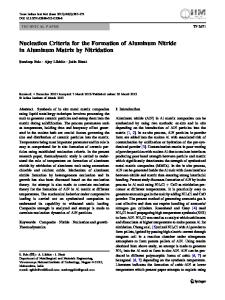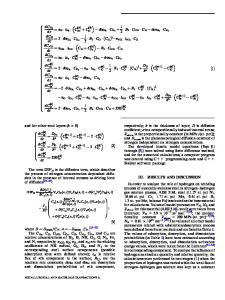Formation of Aluminum Nitrides by Precipitate-Accommodated Plasma Nitriding
- PDF / 1,679,826 Bytes
- 6 Pages / 612 x 792 pts (letter) Page_size
- 44 Downloads / 325 Views
1040-Q08-09
Formation of Aluminum Nitrides by Precipitate-Accommodated Plasma Nitriding Tatsuhiko Aizawa1,2, and Patama Vissutipitukul3 1 R&D Center, AsiaSEED Institute, 3-15-10 Minami-Rokugo, Ota, 144-0045, Japan 2 Osaka Prefecture University, Osaka, 599-8531, Japan 3 Chularonkorn University, Bangkok, Thailand ABSTRACT Precipitate accommodated nitriding is proposed as a new, non-traditional surface treatment of aluminum alloys. In the case of nitriding the aluminum-copper alloys, Al2Cu plays an important role, as a nucleation site to form AlN by the two step reactions of Al2Cu + 2N 2AlN + Cu and Cu + 2Al Al2Cu, and, as a helper to preserve the fast nitrogen diffusion path. In this precipitate accommodation, AlN islands form on Al2Cu in coherent, and, gradually cover the matrix surface by the AlN layer. This Al2Cu accommodation in nucleation reduces the presputtering time and shortens the incubation time prior to formation of AlN layer. Furthermore, the interface between Al2Cu and AlN, becomes a nitrogen diffusion path across the nitrided layer. This Al2Cu accommodation in growth of AlN layer accelerates the growth rate of AlN layer in practice. The formation rate of AlN approaches to 7 μm/ks in the present nitriding. This reduction of processing time is much favored for surface treatment of automotive parts and electrical components in practice. Low friction coefficient and low specific wear rate is also attained in dry sliding condition by this AlN-layered specimen: μ = 0.13 and Ws = 1.5 x 10-5 mm3N-1m-1. Since Al2Cu is a common precipitate to most of aluminum alloys, this AlN-layer formation is also favored to protective coating for automotive parts and electric components. INTRODUCTION Aluminum alloys are widely used for automotive parts like piston or cylinder-head [1] and for electric components like heat exchanger or heat sink [2]. They have high specific strength, high corrosion resistance and high thermal conductivity; while, low hardness and low wear resistance becomes a main issue of nuisance to hinder wider applications of aluminum alloys in practice. In addition to anodizing and ceramic coating [3], formation of aluminum nitride (AlN) layer via nitriding has grown to be a powerful means to overcome the above difficulty. In the normal plasma nitriding, where formation of AlN layer is driven by diffusion of nitrogen atoms through the formed AlN layer, the thickness of AlN layer is limited by 1 to 5 μm even after eight-hour nitriding at 723 K [4, 5]. The plasma ion immersion implantation [6] is effective to form a thick AlN layer up to 10 to 15 μm but needs a relatively longer duration of five hours at high temperature of 823 K. New plasma nitriding is needed to shorten the whole duration of nitriding process, to control the AlN layer thickness up to 100 μm range and to lower the processing temperature. Authors [7-9] have proposed a precipitate accommodated plasma nitriding to have high formation rate of AlN layer even via low-temperature nitriding. In the present paper, this new plasma nitriding is furth
Data Loading...










